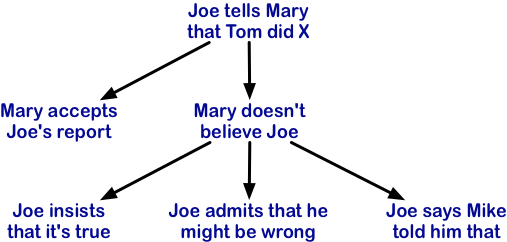I am frustrated. I have spent the last 24 hours struggling with the imagery for the verbs to express challenge and response to the truthfulness of a statement of a past event. Here’s the basic spaghetti diagram using text:

It’s obvious that the glyphs should use a motif based on the katsin (truth) symbol. This would mean that “doesn’t believe” would involve an inverted katsin symbol (inside a black square). I’d want to modify it with an uncertainty adverb as explained here. Then “insists truth” would have to be a standard katsin symbol modified by an uncertainty adverb. But what then would “admits might be wrong” look like? The same as “doesn’t believe”?
I think my problem here is the distinction between objective certainty and emotional certainty. “I don’t believe it slightly” is emotionally nothing at all like “I might be wrong”, even though in objective terms the two statements are similar.
Perhaps the solution is to rely on a 4Actor: “Mary tells Joe that she doesn’t believe Joe a little” followed by “Joe tells Mary that he does believe Mary a little.” But in this case, how would “Joe insists that it’s true” be expressed? “Joe tells Mary that he does believe Joe strongly?” Are they arguing about the person or the truth value of the report?
I could expand it into something very clumsy but specific: “Mary tells Joe that Tom did X is not true a lot” followed by “Joe tells Mary that Tom did X is true a lot” or “Joe tells Mary that Tom did X is untrue a little”. No, that doesn’t work, either.
Perhaps I should distinguish between insisting on the truth and acknowledging the possibility of error. In this case, I’d want to use a motif suggesting probability or possibility. What could that be? A percentage sign? That works, but seems too earth-cultury. A tiny branching tree? That works for me, but I doubt most people would recognize it’s implication of subjunctivity. A pair of scales? That usually implies justice or choice, not probability.
So I get my reference books on symbols out of the library. Unipix has nothing. A Dictionary of Symbols is in inverted order: it is organized by what the symbols are, not what they mean. Thus, there’s a listing for “lion” explaining that it means “strength”, “power”, or “royalty”. There are no listings for these ideas themselves. Symbol Sourcebook is, as always, a delight to peruse; it has symbols for such things as fulguration, butter-churns, and wax, but nothing specific to my needs. The three-dot symbol that in mathematics means “therefore” might be adaptable to this use. Or perhaps I could go wild and just use some highly distinctive abstract symbol and ask the user to figure it out.
A Google image search is more productive; it suggests an infinity symbol or a triskelion. While perusing it, I see a die (as in ‘dice’) and come up with my own idea: a flipping coin. That’s a little earth-cultury, but maybe it will work. So I tried it out, and I wasn’t happy with the result. Next came the idea of choice: the back of a head and two doors in front of the head. No soap. So here are the ideas I have so far:

About that last glyph: just kidding.Looking them over, I think that the triskelion is so distinctive that users will have no problem remembering its meaning once they have learned it. I’ll go with that — for now. Perhaps when a genuine graphic artist reworks all the glyphs, they’ll come up with something better.
